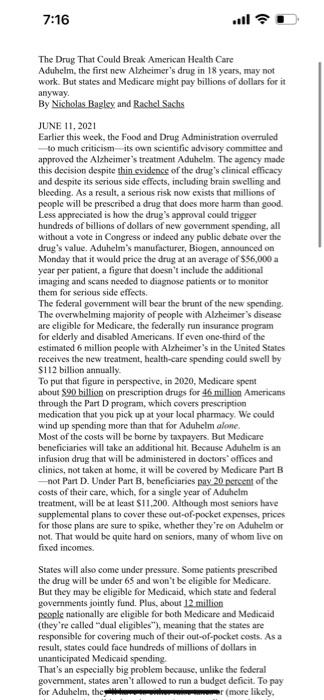
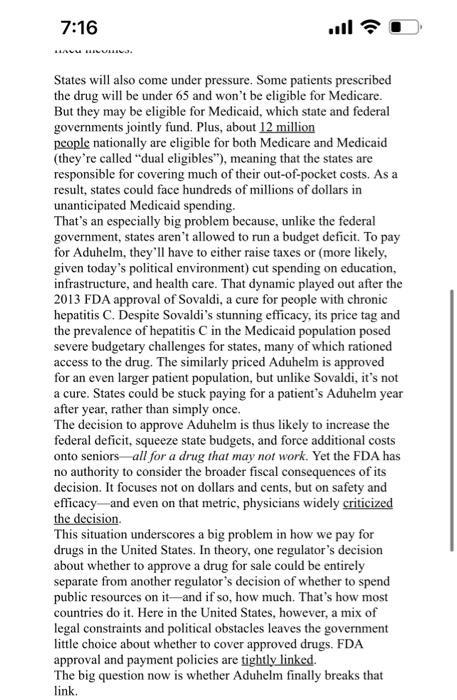
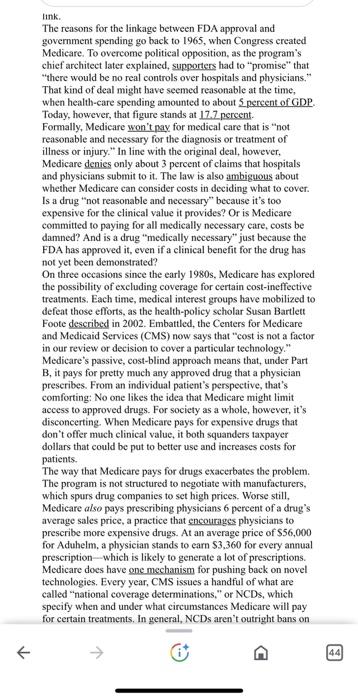
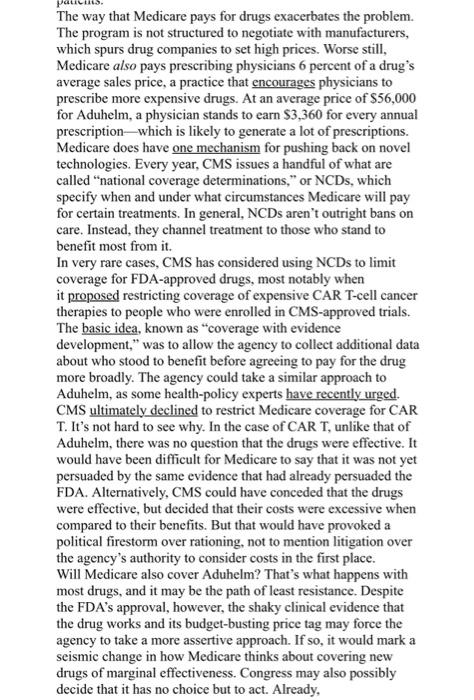
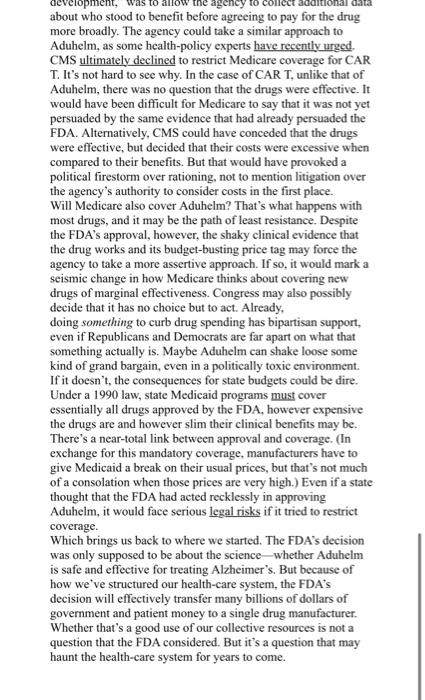
The Drug That Could Break American Health
Care Questions
- The Food and Drug Administration approved the
- Alzheimer's drug Aduhelm even though it was criticized by whom:
- What government health program will bear the brunt of Aduhelm's cost:
- Why will the cost of using this drug have to be covered under Medicare Part B:
- What will happen to the price of premiums for Medicare supplemental plans due to the cost of Aduhelm:
- What is the term that is used for people who are covered by both Medicare and Medicaid:
- Why would Aduhelm have to be taken and paid for year after year as opposed to the Hepatitis drug Sovaldi:
- One of the items that helped pass the Medicare health policy was that there would be no government control over whom:
- Does Medicare consider cost as a factor in their review or decision to cover a particular technology:
- What might be an incentive for physicians to prescribe the drug Aduhelm besides patient care:
- When looking at Aduhelm in a strictly medical results view do experts feel it will have a positive success rate:
The Drug That Could Break American Health Care Aduhelm, the first new Alzheimer's drug in 18 years, may not work. But states and Medicare might pay billions of dollars for it anyway. By Nicholas Bagley and Rachel Sachs JUNE 11, 2021 Earlier this week, the Food and Drug Administration overruled to much criticism - its own scientific advisory committec and approved the Alzheimer's treatment Aduhelm. The agency made this decision despite thin evidence of the drug's clinical efficacy and despite its serious side effects, including brain swelling and bleeding. As a result, a serious risk now exists that millions of people will be prescribed a drag that does more harm than good Less appreciated is how the drug's approval could trigger hundreds of billions of dollars of new government spending, all withour a vote in Congress or indeed any public debate over the drug's value, Aduhelm's manufacturer, Biogen, announced on Monday that it would price the drug at an average of $56,000 a year per patient, a figure that doesn't include the additional imaging and scans needed to diagnose patients or to monitor them for serious side effects. The federal govemment will bear the brunt of the new spending. The overwhelming majority of people with Alzheimer's disease are eligible for Medicare, the federally run insurance program for elderly and disabled Americans. If even one-third of the estimated 6 million people with Alzheimer's in the United States receives the new treatment, health-care spending could swell by $112 billion annually. To put that figure in perspective, in 2020, Medicare spent about $90 billion on prescription drugs for 46 million Americans through the Part D program, which covers prescription medication that you pick up at your local pharmacy. We could wind up spending more than that for Adubelm alone. Most of the costs will be borne by taxpayers. But Medicare beneficiaries will take an additional hit. Because Aduhelm is an infusion drug that will be administered in doctors' offices and clinies, not taken at home, it will be covered by Medicare Part B - not Part D. Under Part B, beneficiaries pay 20 pereent of the costs of their care, which, for a single year of Aduhelm treatment, will be at least $11,200. Although most semiors have supplemental plans to cover these out-of-pocket expenses, prices for those plans are sure to spike, whether they're on Aduhelm or not. That would be quite hard on seniors, many of wbom live on fixed incomes. States will alse come under pressure. Some patients prescribed the drug will be under 65 and won't be eligible for Medicare. But they may be eligible for Medieaid, which state and federal governments jointly fund. Plus, about 12 million people nationally are eligible for both Medicare and Medicaid (they're called "dual eligibles"), meaning that the states are responsible for covering much of their out-of-pocket costs. As a result, states could face hundreds of millions of dollars in enanticipated Medicaid spending. That's an especially big problem because, unlike the federal government, states aren't allowed to run a budget deficit. To pay States will also come under pressure. Some patients prescribed the drug will be under 65 and won't be eligible for Medicare. But they may be eligible for Medicaid, which state and federal governments jointly fund. Plus, about 12 million people nationally are eligible for both Medicare and Medicaid (they're called "dual eligibles"), meaning that the states are responsible for covering much of their out-of-pocket costs. As a result, states could face hundreds of millions of dollars in unanticipated Medicaid spending. That's an especially big problem because, unlike the federal government, states aren't allowed to run a budget deficit. To pay for Aduhelm, they'll have to either raise taxes or (more likely, given today's political environment) cut spending on education, infrastructure, and health care. That dynamic played out after the 2013 FDA approval of Sovaldi, a cure for people with chronic hepatitis C. Despite Sovaldi's stunning efficacy, its price tag and the prevalence of hepatitis C in the Medicaid population posed severe budgetary challenges for states, many of which rationed access to the drug. The similarly priced Aduhelm is approved for an even larger patient population, but unlike Sovaldi, it's not a cure. States could be stuck paying for a patient's Aduhelm year after year, rather than simply once. The decision to approve Aduhelm is thus likely to increase the federal deficit, squeeze state budgets, and force additional costs onto seniors - all for a drug that may not work. Yet the FDA has no authority to consider the broader fiscal consequences of its decision. It focuses not on dollars and cents, but on safety and efficacy-and even on that metric, physicians widely criticized the decision. This situation underscores a big problem in how we pay for drugs in the United States. In theory, one regulator's decision about whether to approve a drug for sale could be entirely separate from another regulator's decision of whether to spend public resources on it-and if so, how much. That's how most countries do it. Here in the United States, however, a mix of legal constraints and political obstacles leaves the government little choice about whether to cover approved drugs. FDA approval and payment policies are tightly linked. The big question now is whether Aduhelm finally breaks that link. Iink. The reasons for the linkage between FDA approval and government spending go back to 1965 , when Congress ereated Medicare. To overcome political opposition, as the program's chief architect later explained, supporters had to "promise" that "there would be no real controls over hospitals and physicians," That kind of deal might have seemed reasonable at the time, when health-care spending amounted to about 5 percent of GDP. Today, however, that figure stands at 17.7 percent. Formally, Medicare won't nay for medical care that is "not reasonable and necessary for the diagnosis or treatment of illness or injury." In line with the original deal, however, Medicare denies only about 3 percent of claims that hospitals and physicians submit to it. The law is also ambiguous about whether Medicare can consider costs in deciding what to cover. Is a drug "not reasonable and necessary" because it's too expensive for the clinical value it provides? Or is Medicare committed to paying for all medically necessary care, costs be damned? And is a drug "medically necessary" just because the FDA has approved it, even if a clinical benefit for the drug has not yet been demonstrated? On three occasions since the early 1980s, Medicare has explored the possibility of excluding coverage for certain cost-ineffective treatments. Each time, medical interest groups have mobilized to defeat those efforts, as the health-policy scholar Susan Bartlett Foote described in 2002. Embattled, the Centers for Medicare and Medicaid Services (CMS) now says that "cost is not a factor in our review or decision to cover a particular technology." Medicare's passive, cost-blind approach means that, under Part B, it pays for pretty much any approved drug that a physician prescribes. From an individual patient's perspective, that's comforting: No one likes the idea that Medicare might limit access to approved drugs. For society as a whole, however, it's disconcerting. When Medicare pays for expensive drugs that don't offer much clinical value, it both squanders taxpayer dollars that could be put to better use and increases costs for patients. The way that Medicare pays for drugs exacerbates the problem. The program is not structured to negotiate with manufacturers, which spurs drug companies to set high prices. Worse still, Medicare also pays prescribing physicians 6 percent of a drug's average sales price, a practice that encourages physicians to prescribe more expensive drugs. At an average price of $56,000 for Aduhelm, a physician stands to earn $3,360 for every annual prescription - which is likely to generate a lot of prescriptions. Medicare docs have one mechanism for pushing back on novel technologies. Every year, CMS issues a handful of what are called "national coverage determinations," or NCDs, which specify when and under what circumstances Medicare will pay for certain treatments, In general, NCDs aren't outright bans on The way that Medicare pays for drugs exacerbates the problem. The program is not structured to negotiate with manufacturers, which spurs drug companies to set high prices. Worse still, Medicare also pays prescribing physicians 6 percent of a drug's average sales price, a practice that encourages physicians to prescribe more expensive drugs. At an average price of $56,000 for Aduhelm, a physician stands to earn $3,360 for every annual prescription - which is likely to generate a lot of prescriptions. Medicare does have one mechanism for pushing back on novel technologies. Every year, CMS issues a handful of what are called "national coverage determinations," or NCDs, which specify when and under what circumstances Medicare will pay for certain treatments. In general, NCDs aren't outright bans on care. Instead, they channel treatment to those who stand to benefit most from it. In very rare cases, CMS has considered using NCDs to limit coverage for FDA-approved drugs, most notably when it proposed restricting coverage of expensive CAR T-cell cancer therapies to people who were enrolled in CMS-approved trials. The basic idea, known as "coverage with evidence development," was to allow the agency to collect additional data about who stood to benefit before agreeing to pay for the drug more broadly. The agency could take a similar approach to Aduhelm, as some health-policy experts have recently urged. CMS ultimately declined to restrict Medicare coverage for CAR T. It's not hard to see why. In the case of CAR T, unlike that of Aduhelm, there was no question that the drugs were effective. It would have been difficult for Medicare to say that it was not yet persuaded by the same evidence that had already persuaded the FDA. Alternatively, CMS could have conceded that the drugs were effective, but decided that their costs were excessive when compared to their benefits. But that would have provoked a political firestorm over rationing, not to mention litigation over the agency's authority to consider costs in the first place. Will Medicare also cover Aduhelm? That's what happens with most drugs, and it may be the path of least resistance. Despite the FDA's approval, however, the shaky clinical evidence that the drug works and its budget-busting price tag may force the agency to take a more assertive approach. If so, it would mark a seismic change in how Medicare thinks about covering new drugs of marginal effectiveness. Congress may also possibly decide that it has no choice but to act. Already, about who stood to benefit before agreeing to pay for the drug more broadly. The agency could take a similar approach to Aduhelm, as some health-policy experts have recently urged. CMS ultimately declined to restrict Medicare coverage for CAR T. It's not hard to see why. In the case of CAR T, unlike that of Aduhelm, there was no question that the drugs were effective. It would have been difficult for Medicare to say that it was not yet persuaded by the same evidence that had already persuaded the FDA. Alternatively, CMS could have conceded that the drugs were effective, but decided that their costs were excessive when compared to their benefits. But that would have provoked a political firestorm over rationing, not to mention litigation over the agency's authority to consider costs in the first place. Will Medicare also cover Aduhelm? That's what happens with most drugs, and it may be the path of least resistance. Despite the FDA's approval, however, the shaky clinical evidence that the drug works and its budget-busting price tag may force the agency to take a more assertive approach. If so, it would mark a seismic change in how Medicare thinks about covering new drugs of marginal effectiveness. Congress may also possibly decide that it has no choice but to act. Already. doing something to curb drug spending has bipartisan support, even if Republicans and Democrats are far apart on what that something actually is. Maybe Aduhelm can shake loose some kind of grand bargain, even in a politically toxic environment. If it doesn't, the consequences for state budgets could be dire. Under a 1990 law, state Medicaid programs must cover essentially all drugs approved by the FDA, however expensive the drugs are and however slim their clinical benefits may be. There's a near-total link between approval and coverage. (In exchange for this mandatory coverage, manufacturers have to give Medicaid a break on their usual prices, but that's not much of a consolation when those prices are very high.) Even if a state thought that the FDA had acted recklessly in approving Aduhelm, it would face serious legal risks if it tried to restrict coverage. Which brings us back to where we started. The FDA's decision was only supposed to be about the science - whether Aduhelm is safe and effective for treating Alzheimer's. But because of how we've structured our health-care system, the FDA's decision will effectively transfer many billions of dollars of government and patient money to a single drug manufacturer. Whether that's a good use of our collective resources is not a question that the FDA considered. But it's a question that may haunt the health-care system for years to come











